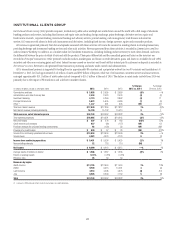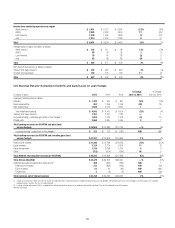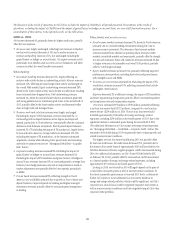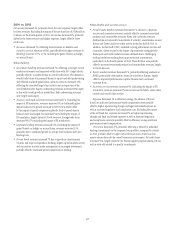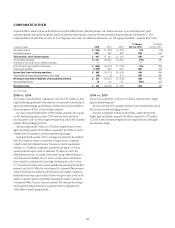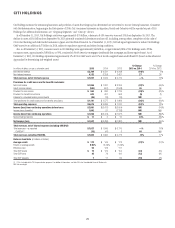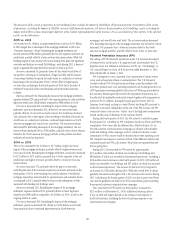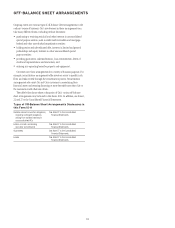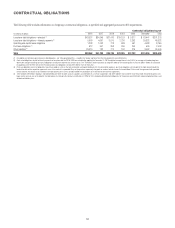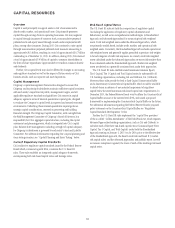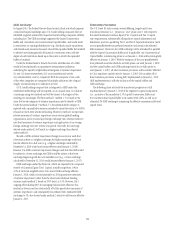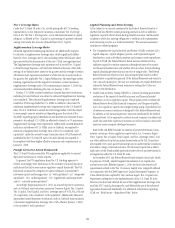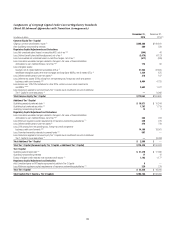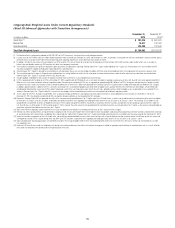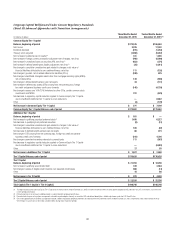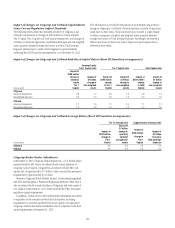Citibank 2015 Annual Report Download - page 52
Download and view the complete annual report
Please find page 52 of the 2015 Citibank annual report below. You can navigate through the pages in the report by either clicking on the pages listed below, or by using the keyword search tool below to find specific information within the annual report.34
GSIB Surcharge
In August 2015, the Federal Reserve Board issued a final rule which imposes
a risk-based capital surcharge upon U.S. bank holding companies that are
identified as global systemically important bank holding companies (GSIBs),
including Citi. The GSIB surcharge augments the Capital Conservation
Buffer and, if invoked, any Countercyclical Capital Buffer, and would result
in restrictions on earnings distributions (e.g., dividends, equity repurchases,
and discretionary executive bonuses) should the expanded buffer be breached
to absorb losses during periods of financial or economic stress, with the
degree of such restrictions based upon the extent to which the expanded
buffer is breached.
Under the Federal Reserve Board’s final rule, identification of a GSIB
would be based primarily on quantitative measurement indicators
underlying five equally weighted broad categories of systemic importance:
(i) size, (ii) interconnectedness, (iii) cross-jurisdictional activity,
(iv) substitutability, and (v) complexity. With the exception of size, each
of the other categories are comprised of multiple indicators also of equal
weight, and amounting to 12 indicators in total.
A U.S. bank holding company that is designated a GSIB under the
established methodology will be required, on an annual basis, to calculate
a surcharge using two methods and will be subject to the higher of the
resulting two surcharges. The first method (“method 1”) is based on the
same five broad categories of systemic importance used to identify a GSIB.
Under the second method (“method 2”), the substitutability category is
replaced with a quantitative measure intended to assess the extent of a GSIB’s
reliance on short-term wholesale funding. Moreover, method 1 incorporates
relative measures of systemic importance across certain global banking
organizations and a year-end spot foreign exchange rate, whereas method 2
uses fixed measures of systemic importance and application of an average
foreign exchange rate over a three-year period. Generally, the surcharge
derived under method 2 will result in a higher surcharge than derived
under method 1.
Should a GSIB’s systemic importance change year-over-year such that
it becomes subject to a higher surcharge, the higher surcharge would not
become effective for a full year (e.g., a higher surcharge calculated by
December 31, 2016 would not become effective until January 1, 2018).
However, if a GSIB’s systemic importance changes such that the GSIB would
be subject to a lower surcharge, the GSIB would be subject to the lower
surcharge beginning with the next calendar year (e.g., a lower surcharge
calculated by December 31, 2016 would become effective January 1, 2017).
GSIB surcharges under the final rule, which are required to be composed
entirely of Common Equity Tier 1 Capital, initially range from 1.0% to
4.5% of total risk-weighted assets. Citi’s initial GSIB surcharge effective
January 1, 2016, which is based primarily on 2014 quantitative measures
of systemic importance (other than the short-term wholesale funding
measure under method 2, based on 2015 data), is 3.5%. However, Citi’s
ongoing efforts during 2015 in managing balance sheet efficiency has
resulted in lower scores for substantially all of the quantitative measures of
systemic importance, and consequently has reduced Citi’s estimated GSIB
surcharge to 3%, also derived under method 2, which would become effective
January 1, 2017.
Transition Provisions
The U.S. Basel III rules contain several differing, largely multi-year
transition provisions (i.e., “phase-ins” and “phase-outs”) with respect to
the stated minimum Common Equity Tier 1 Capital and Tier 1 Capital
ratio requirements, substantially all regulatory capital adjustments and
deductions, and non-qualifying Tier 1 and Tier 2 Capital instruments (such
as non-grandfathered trust preferred securities and certain subordinated
debt issuances). Moreover, the GSIB surcharge will be introduced in parallel
with the Capital Conservation Buffer and, if applicable, any Countercyclical
Capital Buffer, commencing phase-in on January 1, 2016 and becoming fully
effective on January 1, 2019. With the exception of the non-grandfathered
trust preferred securities which do not fully phase-out until January 1, 2022
and the capital buffers and GSIB surcharge which do not fully phase-in
until January 1, 2019, all other transition provisions will be entirely reflected
in Citi’s regulatory capital ratios by January 1, 2018. Citi considers all of
these transition provisions as being fully implemented on January 1, 2019
(full implementation), with the inclusion of the capital buffers and
GSIB surcharge.
The following chart sets forth the transitional progression to full
implementation by January 1, 2019 of the regulatory capital components
(i.e., inclusive of the mandatory 2.5% Capital Conservation Buffer and
the Countercyclical Capital Buffer at its current level of 0%, as well as an
estimated 3% GSIB surcharge) comprising the effective minimum risk-based
capital ratios.


